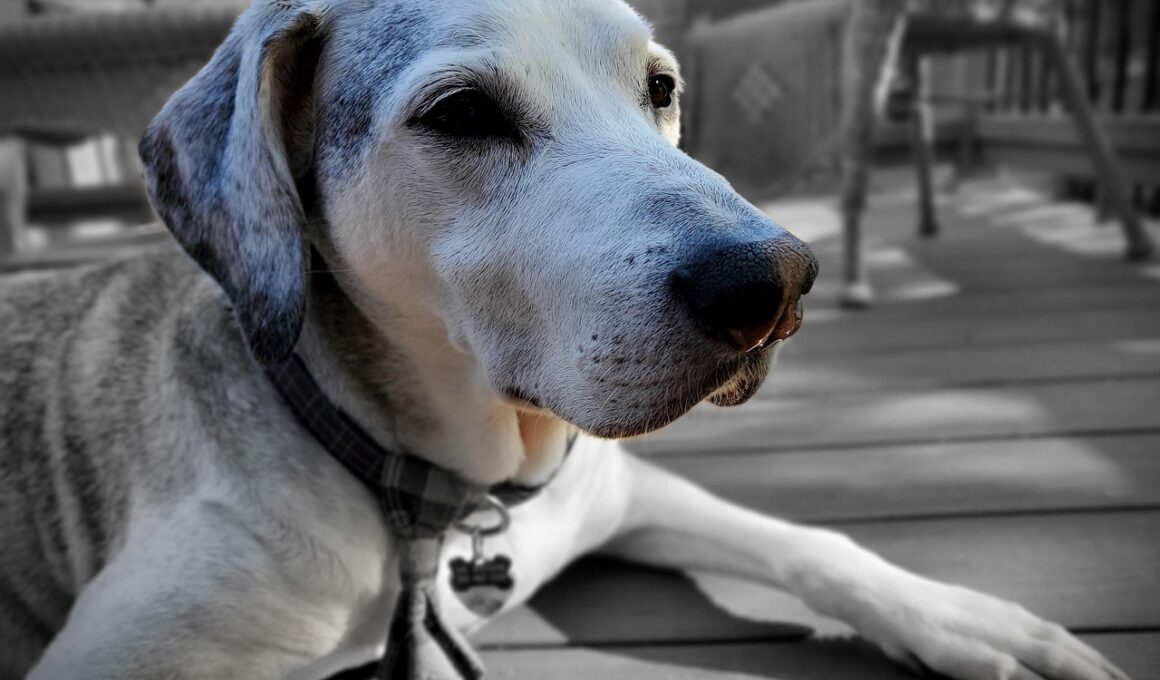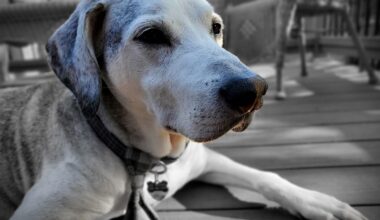Understanding Senior Dogs and Mobility Issues
As dogs age, they may face mobility issues that can affect their overall quality of life. Mobility problems can arise from various conditions, including arthritis, hip dysplasia, or general weakness. These health concerns are common among senior dogs, making it essential for owners to understand how to address the unique safety needs associated with these issues. Dogs with decreased mobility often require extra attention, support, and accommodations within their living environments. Providing a suitable space that considers these factors is paramount to their wellbeing and comfort. It is crucial to identify signs of mobility problems early. Dogs may exhibit changes in behavior such as reluctance to jump or climb stairs. Furthermore, older dogs might become less active or show discomfort during regular activities. Owners should monitor their pets closely and consult veterinarians regularly for assessments. Adapting the home environment to meet an aging dog’s needs can significantly enhance their safety and satisfaction. Soft bedding, accessible food and water stations, and non-slip flooring can be crucial adjustments. Taking proactive measures will ensure that senior dogs can navigate their surroundings confidently and safely.
Home Modifications for Enhanced Safety
To accommodate dogs with mobility issues, modifying the living environment becomes essential. Simple changes can dramatically improve safety and comfort for senior dogs. First, consider eliminating obstacles that can impede movement. Remove unnecessary furniture or clutter, creating clear pathways. Implementing non-slip surfaces, including rugs and mats, can help prevent slips and falls. Moreover, providing ramps can dramatically ease the task of accessing higher surfaces like couches or beds without strain. Stairs may pose significant risks for dogs with limited mobility. Installing baby gates can aid in regulating areas of the home they should avoid. Additionally, a designated area for play and rest should be arranged, allowing easy access without the risk of injury. Regular maintenance of the dog’s environment is key. Checking and adjusting their space according to seasonal changes ensures it remains safe year-round. Moreover, keeping the outdoors secure, with safely fenced areas and controlled access, supports their exploration without the aforementioned dangers. Through modifications and careful planning, senior dogs can enjoy a safe and vibrant life in their familiar homes.
As dogs with mobility issues often require adjusted routines, incorporating tools and assistive devices can effectively improve their day-to-day lives. Various products designed specifically for senior dogs are available on the market, offering support where it is most needed. Harnesses can provide extra support for assistance during walks, allowing owners to help their dogs avoid straining themselves. Additionally, specialized dog wheelchairs can facilitate mobility for those with severe disability, providing freedom encouraging participation in outdoor activities. Elevated food and water bowls can also make feeding time easier, reducing strain on their necks and joints. A variety of orthopedic beds designed to provide additional support for aching joints can allow better sleep and recovery. Always choose products that are designed thoughtfully for senior dogs, ensuring the items are lightweight yet durable, and consult with a veterinarian when necessary. Furthermore, grooming tools made for seniors, such as softer brushes, can enhance comfort during routine hygiene activities. Keeping all of these factors in mind will allow owners to prioritize their furry companions’ comfort and encourage their overall happiness despite age-related challenges.
Regular veterinary check-ups play a crucial role in managing the health of senior dogs, especially those struggling with mobility issues. Veterinary professionals can identify early signs of trouble and offer timely interventions that can ease discomfort and improve quality of life. Scheduling routine check-ups enhances the pet’s healthcare plan, including vaccinations, heartworm tests, and dental examinations. Furthermore, discussing any observed behavioral changes or issues with mobility can lead to tailored advice on managing these conditions. Owners might be encouraged to invest in joint supplements or prescribed medications to alleviate pain associated with arthritis. Physical therapy can also be an effective path to consider, providing structured support for recovery and maintaining mobility. Hydrotherapy has gained popularity as a safe and enjoyable method for encouraging joint mobility and muscle strength. Besides providing physical support, regular check-ups foster responsible pet ownership. By establishing a good relationship with their veterinarian, pet owners can access a broad network of expertise, guidance, and resources that cater to the special needs of senior dogs. Understanding and applying this knowledge is key to ensuring a happy, comfortable life for aging pets.
Therapeutic in-home solutions can significantly contribute to the overall safety and comfort of senior dogs with mobility challenges. Many pet owners may overlook such alternatives that can be implemented readily within their own homes. Firstly, heat therapy can alleviate pain in arthritic joints, providing enhanced comfort. Heat pads designed especially for dogs can be strategically placed near sleeping areas or used during resting times. Cold therapy, on the other hand, can help reduce inflammation during flare-ups and is another helpful resource. Additionally, exploring gentle massage techniques can help relieve stiffness and improve blood flow, providing a soothing experience for the dog. Some may find alternative treatments like acupuncture effective, offering ancient modalities that can address various health problems. However, always consult with qualified professionals before exploring these treatments. Moreover, keeping the dog engaged mentally and socially is vital for emotional well-being. Simple games and social interactions with family members can help reduce feelings of anxiety associated with physical limitations. Combining these strategies results in a holistic approach to fostering a joyful atmosphere in which senior dogs can thrive, despite their challenges.
Ensuring a safe and positive experience during outdoor activities for senior dogs with mobility issues is essential. These outings are pivotal for maintaining their physical and mental health. However, extra caution is necessary to prevent harm or injuries that may arise from their limitations. Opt for flat, even surfaces when choosing where to walk, as uneven terrain might increase the risk of falls. Furthermore, limit the distance covered to avoid overexertion and fatigue, adjusting based on the dog’s physical capabilities. Keeping outdoor excursions shorter yet more frequent is often more beneficial. Carrying portable water and ensuring rest breaks during walks guarantees that the dog stays hydrated and never feels overwhelmed. Adding a wide variety of sights and sounds will keep their mind active and engaged while boosting their overall happiness. Always bring along supportive equipment like harnesses and leashes designed for senior dogs, ensuring security during outings. Keep the dog on a leash to safely control their interactions and prevent them from wandering off. Such considerations enhance the experience of outdoor time significantly while prioritizing the dog’s well-being and safety at all times.
Finally, fostering a deep bond with a senior dog requires an understanding of their shifting needs, especially regarding their mobility restrictions. Effective communication goes hand in hand with recognizing and responding to behavioral changes resulting from age-related health challenges. Building trust is crucial for bolstering their confidence during vulnerable moments. For example, offering praise whenever they attempt new movements can positively reinforce their courage and perseverance. Quality time spent with senior dogs can also take various forms, adapting to their changing needs without the necessity of strenuous physical activities. Gentle grooming sessions or simple companionship can be extremely comforting. Engaging in short and positive playtimes can enhance not only physical health but mental engagement as well. Furthermore, educating oneself about the aging process for dogs is key to addressing their unique challenges adequately. This knowledge empowers owners to make informed choices that prioritize comfort and safety, ultimately strengthening the bond between dog and owner. By bringing awareness to various aspects of senior dog care, owners can create a compassionate atmosphere that celebrates their pets’ journey through life.


